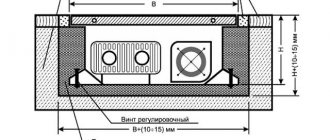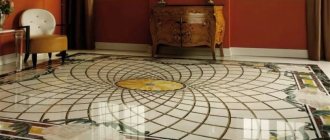Installation of window sills is an important stage of construction, which simultaneously ensures comfort and safety in rooms for various functional purposes. Thanks to well-chosen geometric parameters and high-quality installation, the window sill board fully satisfies the required indicators for strength, reliability and durability, maintaining its original technological characteristics throughout the entire operational period.
Currently, concrete window sills are becoming increasingly popular because, in addition to their high strength and reliability, they are distinguished by a wide variety of geometry and textures to suit every taste.
- What document regulates the installation of window sill slabs?
- What should be the height/distance of the window sill from the floor?
- How long should the window sill be?
- How far should it protrude from the wall?
- How to choose the right width?
- How deep should the window sill be?
- What thickness?
- What should the slope of the window sill be according to GOST?
- What should be the installation of a window sill according to GOST: video
What size should the window sill overhang be made?
Good afternoon
Are there any criteria for determining the size of the window sill protrusion? The room has 4 windows under two window sills and there are radiators. I read in one thread that people are making a protrusion half the depth of the radiator. The size of the window sill itself (95x50). It seems that the eye asks for a protrusion of 3 cm, but the worker suggests 5 cm. Manufacturers of radiators and convectors, heating designers ask not to block the air flow from above or to use more power. I made a 17 mm projection, purmo convectors.
I have convectors “Cast iron radiator” 10 sections MS-140 made in Cheboksary.
Freq wrote: It seems that the eye is asking to make a protrusion of 3 cm, but the worker suggests 5 cm.
People do whatever they want. Sometimes, according to a design project, a table top comes from the window. The radiator is not visible at all. In short, “in life,” as you do, so it will be.
Yes, only if there is a tabletop leading from the window, it is advisable to provide holes in it directly below the window, because the cold flow from the window is a very unpleasant thing if it is not cut off by rising warm air
If the window sill completely blocks the radiator, plus a curtain, the window may fog up.
demin68 wrote: If the window sill completely blocks the radiator, plus a curtain, the window may fog up.
If the curtain is at least a couple of centimeters longer than the window sill, then on the contrary, the window will never fog up. The curtain will play the role of a screen, directing warm air from the radiators onto the glass.
Freq wrote: I read in one thread that people are making a protrusion half the depth of the radiator.
And rightly so, at one time, at my wife’s request, I ordered wide ones, then cut the holes myself (the window naturally fogged up). Ultimately, during the repair, I replaced everything with a protrusion half the depth of the radiator!
micin wrote: Yes, only if there is a tabletop from the window, it is advisable to provide holes in it directly under the window, because the cold flow from the window is a very unpleasant thing if it is not cut off by rising warm air
That’s right. Just like I read somewhere here: “The designer first of all wants to erect a monument to himself, and only then thinks about the fact that people will live here.”
You can make a protrusion beyond the level with the heating radiator, but then you need to cut a ventilation grille (ducts) into the window sill. I made a protrusion up to half the depth of the radiator (the windows do not sweat when the ratio of the radiator and window sizes is 1/3, the radiator is bimetallic).
There is a GOST for windows, it also says about the window sill. It should not block the radiators. You need to look - GOST specifies the permissible % of overlap.
Yes. But, if you do it according to GOST, then the tax takes into account the year that this GOST came into force. Modern radiators (does not apply to cast iron, more related to bimetallic, aluminum) have a convector outflow of hot air and it is directed towards the room, and not to the window sill, the only thing here is that the distance to the window sill is not tricky.
ashkalikov wrote: There is a GOST for windows,
What if not a secret?
GOST standards for windows: 1. GOST 30674-99 “Window blocks made of polyvinyl chloride profiles”, in Appendix D (recommended) there is only a drawing with a schematic diagram of the installation of a window block. There is no specific figure for the projection of the window sill from the plane of the wall. 2. GOST_23166-99 “Window blocks. General technical conditions" - not a word about the window sill. 3.GOST_30971-02 “Mounting seams of junctions of window blocks to wall openings. General technical conditions" - not a word about the overhang of the window sill. I read some installation instructions from the manufacturer of profile systems. there it was like this - “the window sill board should no longer protrude from the plane of the wall. than 6cm. and at the same time, one more condition must be met - it should not overlap the heating device located underneath it by more than half its thickness.”
The old man wrote: .GOST_30971-02 “Mounting seams of junctions of window blocks to wall openings. General technical conditions" - not a word about the overhang of the window sill.
And what does this have to do with the old and not yet registered GOST?
munya wrote: What does this have to do with the old and not yet registered GOST?
Which department refused to register a GOST that failed to register? In my opinion, this is the Ministry of Justice, and on the basis of this decision, the Ministry of Regional Development issued a document on the abolition of GOST 30971. In my opinion, Mr. Yakovlev’s signature was there. only there was a catch - the Ministry of Justice does not have the right to consider technical standards at all (GOSTs, TUs, SNiPs, etc.), and the Ministry of Justice itself prohibited itself from doing this by a previously issued Order. and according to the law on technical regulation - one organization TC 465 “Construction” registers such documents. And what document, interesting, did you use before the notorious “cancellation” of GOST 30971? Or maybe you are not familiar with this document - “Resolution of the State Standard of Russia dated January 30, 2004 No. 4, Moscow”?
The old man wrote: The Ministry of Justice does not have the right to consider technical standards at all (GOSTs, TUs, SNiPs, etc.),
Decree of the President of the Russian Federation dated May 23, 1996 N 763 “On the procedure for publication and entry into force of acts of the President of the Russian Federation, the Government of the Russian Federation and regulatory legal acts of federal executive authorities” states: “Regulatory legal acts of federal executive authorities, ... not passed state registration, as well as those registered but not published in the prescribed manner, do not entail legal consequences, as they have not entered into force, and cannot serve as a basis for regulating relevant legal relations, applying sanctions to citizens, officials and organizations for failure to comply with the instructions contained therein . These acts cannot be referred to when resolving disputes.” QUOTE=Old man].” And what document, interesting, did you use before the notorious “cancellation” of GOST 30971? In fact, GOST is mandatory only in terms of occupational safety! you don’t know GOST R 52749-2007?
- Call on Skype inchin64
Viber, WhatsApp: +7-906-397-0062
Is the window sill overhang above the radiator the optimal value?
I looked on the website and forum for the answer to my question - should the window sill cover the radiator and by how much? Have not found











